Los Angeles Times
CALIFORNIA
LOS ANGELES EDITION.
Saturday, July 14, 2007
Station 84 is finally getting out of the house
Woodland Hills firefighters in one of the city's last small
bungalow-style firehouses are moving to bigger digs.
By Bob Pool,
Times Staff Writer
He usually leaves it parked outside. But on hot summer days, Paramedic Brent Ruff tries to keep his ambulance cool by squeezing it into a garage that is so tiny, he has to suck in his stomach to shimmy out the driver's door.
It's been a tight fit for more than half a century in Woodland Hills, where the local firehouse is just that: a house.
Measuring about 1,500 square feet, Fire Station 84 is one of the smallest in Los Angeles. Soon, though, it will become one of the city's largest.
Firefighters and rescue squad members are moving to a nearly 25,000-square-foot station outfitted with seven large firetruck bays instead of the cramped, two-car garage they now use.
Construction of the $16-million station at 21050 Burbank Blvd. signals the halfway point of a decade-long campaign to upgrade 20 neighborhood firehouses across Los Angeles. In all, about $379 million is being spent, compliments of Proposition F, a bond issue approved by voters in 2000.
New stations have been built in Panorama City, Encino, Mar Vista, North Hollywood, Sun Valley, Watts, West Los Angeles, Westchester, San Pedro and Van Nuys, where a combination station and helicopter base has been constructed at Van Nuys Airport.
Construction is underway at sites near downtown, Northridge, Palms, the Pico-Union District, San Pedro, South Los Angeles and Studio City, and work is planned for a new station in Hollywood.
Los Angeles Mayor Antonio Villaraigosa and other city officials are scheduled to attend opening ceremonies for Fire Station 81 in Panorama City today at 10 a.m. Public tours of the $20-million regional station and training center at 14355 Arminta St. are among the activities planned.
But it is in Woodland Hills where the contrast between the new and old is most striking.
The west San Fernando Valley was sparsely inhabited in 1949 when the city began constructing Station 84 a block south of pepper tree-lined Canoga Avenue's intersection with Ventura Boulevard.
Authorities were mindful of a brush fire that five years earlier burned down the Woodland Hills Country Club and destroyed 29 homes — many owned by Hollywood figures. About 250 soldiers, 50 youths from the Pacific Lodge Boy's School and homeowners in bucket brigades joined hundreds of professional firefighters on a fire line that stretched eight miles in a hilly area south of Ventura Boulevard.
The Fire Department designed the station at 5340 Canoga Ave. to blend in with neighboring houses. The crew quarters resembled a low-slung residential bungalow. The detached garage housed a pumper truck and a 7,000-gallon water tanker for brush fire work.
About 4,500 people lived in Woodland Hills at the time. A handful of small shops dotted sleepy Ventura Boulevard. What is now Warner Center was a sprawling horse ranch.
"There was no 'downtown' Woodland Hills back then. Most of the population was back up in the hills on the little streets. We kept busy with house fires and brush fires," recalled Jack Brodie, an 83-year-old former firefighter who worked at the firehouse for 14 years before retiring in 1975. "The station was small, but it was plenty big for the four or five of us who would be on duty at any one time."
The residential community grew rapidly in the 1960s. Its business area began booming in the 1970s when Warner Center sprang to life with high-rise offices, apartments and condominiums. Woodland Hills' population today is about 61,000.
The move to the new station is expected to take place in a few weeks. The old station probably will be sold to developers; proceeds from such a sale would go toward upgrading other fire facilities, said Battalion Chief Gary Clark, who is in charge of the Proposition F construction program.
Woodland Hills resident Nora Henson has photographed the old station and its interior and plans to give firefighters souvenir CDs of the images. Homeowners — who often deliver casseroles, pies and cakes to the station — will be sad to see it leave the neighborhood, she said.
Firefighters will miss the coziness of the old station, said Fred Peterson, who drives the station's engine and has worked there for 17 years.
"Moving will be both a happy and sad thing. It will be nice to have some elbow room and be able to get in and out of the apparatus more quickly," he said. "But it's going to be a little sad not to be able to stand in the locker room and talk to somebody who is in the kitchen. Where we are now is so doggone convenient."
Peterson and his co-workers have closely watched the new station take shape over the last 34 months. They like the fact that they won't have to cautiously back the firetruck into the station like they do now. They also appreciate the new amenities — central air conditioning and cable hookups that will accommodate up to 26 TVs. The station will feature a training classroom that can be used for community meetings.
"We currently have three toilets. The new place has 14," Peterson said. "We have two shower stalls. The new place has nine. The new kitchen is like going from the Mayflower to the Starship Enterprise." The new two-story station also has three brass poles that firefighters will slide down when responding to calls from their second-floor sleeping quarters.
"It's been 15 years since I worked in a station with a pole," said Engineer Tom Croell.
"The problem with poles is you can only go one way with them," Capt. Thomas Paulsen reminded Croell. "We'll have to climb the stairs."
Paulsen said the new fire station will have separate facilities for male and female firefighters. A shower curtain suspended across the old station's locker room and a sign on the door that advises whether the bathroom is in use — and if so, by whom — is the way privacy is now handled. Currently, however, no women are assigned to Station 84.
One thing the firefighters are not looking forward to is the upkeep of their new digs.
"Right now you can vacuum the whole station from one electric plug," joked Paramedic Reuben Estrada. "I've suggested that they send in guys from the next closest station to help keep the new place clean."
Although the new station will initially be staffed by six, a battalion chief and his assistant will be headquartered there, officials said. As the West Valley grows, additional firefighters and equipment will be assigned. There will be room for three engine companies and an aerial ladder truck, said Battalion Chief John Duca.
For now, "they'll probably bring in a lot of reserve apparatus there for storage," said retired Station 84 Capt. Dave Bolding.
"There's going to definitely be more work in store for people there," he said. "There's going to be a lot of burden on those assigned there to maintain that equipment."
Bolding, 60, of Westlake Village spent 16 years at the old Woodland Hills station. He said one of the most difficult fire calls he responded to in his career occurred just steps from the new firehouse.
Workers constructing a parking structure at Kaiser Hospital next door to the future station site cut into a major gas line. It erupted in a roaring fire that threatened to set the hospital ablaze.
"The '94 riots were going on at that time and we didn't have a lot of resources because people were downtown fighting fires," Bolding recalled.
No gas lines were harmed, they say, in the making of new Fire Station 84. |
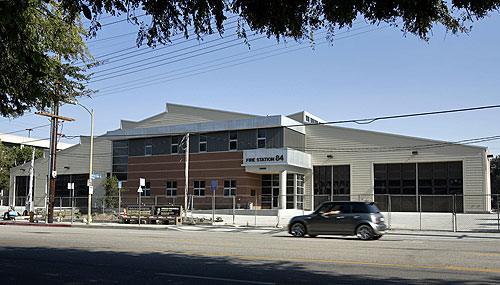 BIGGER DIGS: The new Station 84 going up on Burbank Boulevard will have seven large firetruck bays. (Lawrence K. Ho / LAT) BIGGER DIGS: The new Station 84 going up on Burbank Boulevard will have seven large firetruck bays. (Lawrence K. Ho / LAT)
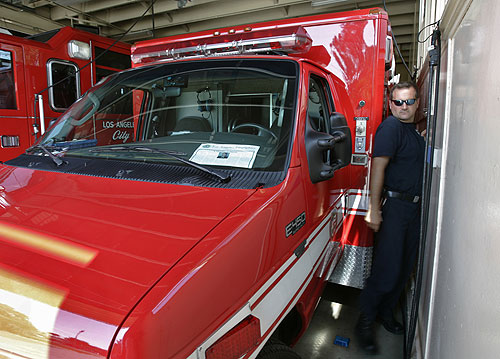 TIGHT SQUEEZE: Paramedic Brent Ruff squeezes out of the ambulance parked inside TIGHT SQUEEZE: Paramedic Brent Ruff squeezes out of the ambulance parked inside
Station 84's garage. The station is a relic of times when Woodland Hills was a tiny Valley community and firehouses were built to blend in.
(Lawrence K. Ho / LAT)
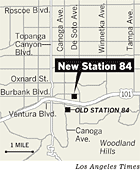
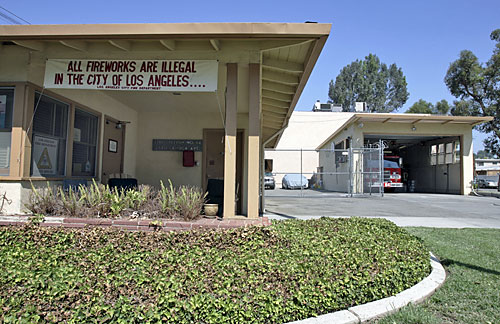 HOUSE AND HOME: Built to resemble a low-slung bungalow, the Canoga Avenue station will be missed by area residents, who often bring casseroles, pies and cakes to the firefighters. HOUSE AND HOME: Built to resemble a low-slung bungalow, the Canoga Avenue station will be missed by area residents, who often bring casseroles, pies and cakes to the firefighters.
(Lawrence K. Ho / LAT)
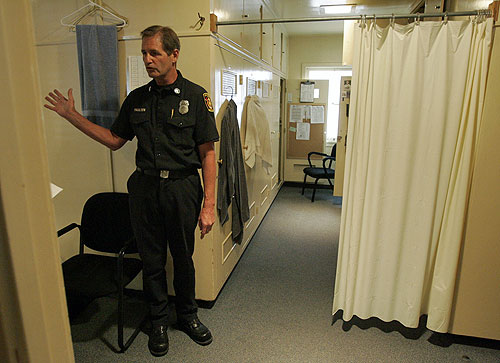 MAKESHIFT PRIVACY: Capt. Thomas J. Paulsen tours the locker area of the old firehouse. The shower curtain offered privacy for female firefighters, though none are currently stationed there. MAKESHIFT PRIVACY: Capt. Thomas J. Paulsen tours the locker area of the old firehouse. The shower curtain offered privacy for female firefighters, though none are currently stationed there.
(Lawrence K. Ho / LAT)
July 5, 2007
|
|
bob.pool@latimes.com
|
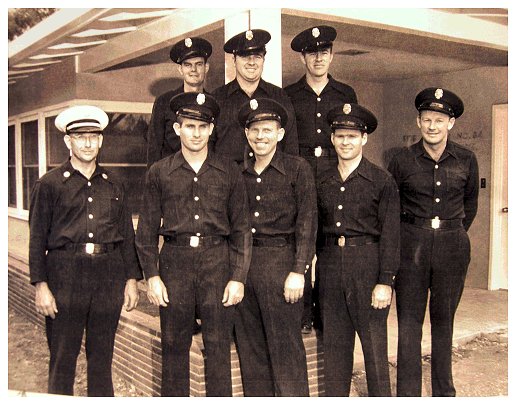
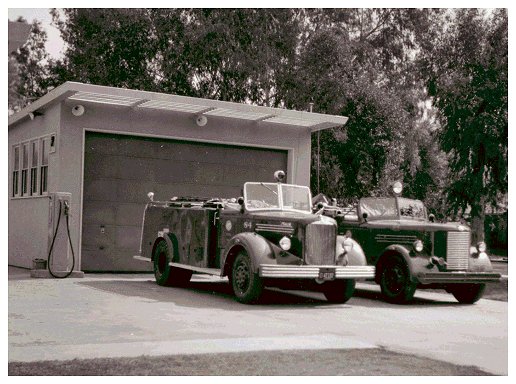
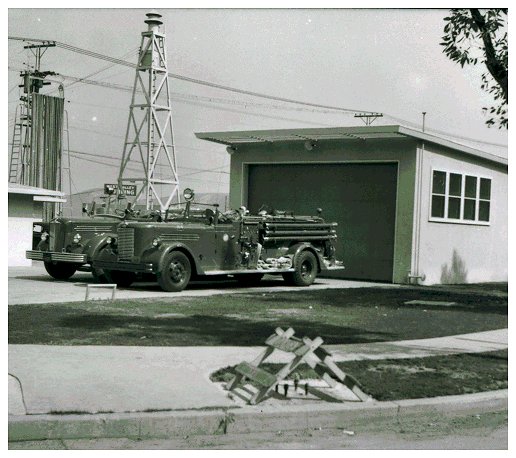
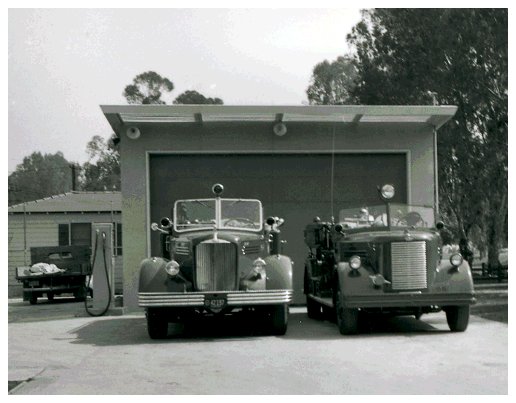
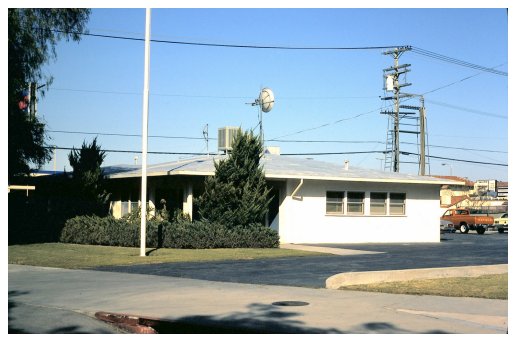
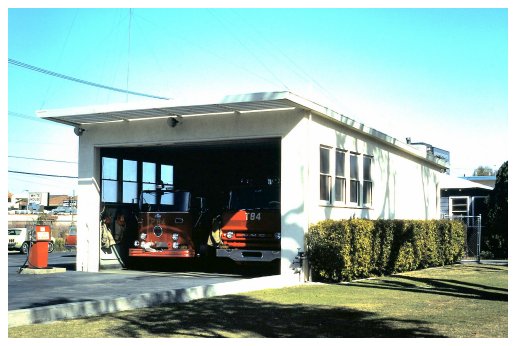
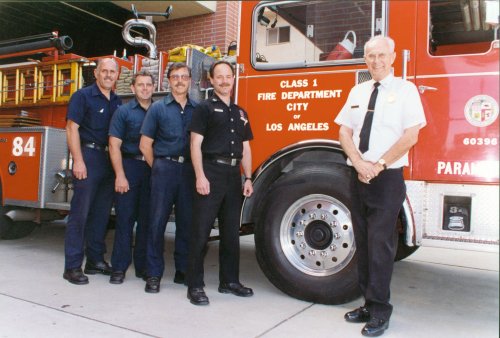
 BIGGER DIGS: The new Station 84 going up on Burbank Boulevard will have seven large firetruck bays. (Lawrence K. Ho / LAT)
BIGGER DIGS: The new Station 84 going up on Burbank Boulevard will have seven large firetruck bays. (Lawrence K. Ho / LAT) TIGHT SQUEEZE: Paramedic Brent Ruff squeezes out of the ambulance parked inside
TIGHT SQUEEZE: Paramedic Brent Ruff squeezes out of the ambulance parked inside 
 HOUSE AND HOME: Built to resemble a low-slung bungalow, the Canoga Avenue station will be missed by area residents, who often bring casseroles, pies and cakes to the firefighters.
HOUSE AND HOME: Built to resemble a low-slung bungalow, the Canoga Avenue station will be missed by area residents, who often bring casseroles, pies and cakes to the firefighters. MAKESHIFT PRIVACY: Capt. Thomas J. Paulsen tours the locker area of the old firehouse. The shower curtain offered privacy for female firefighters, though none are currently stationed there.
MAKESHIFT PRIVACY: Capt. Thomas J. Paulsen tours the locker area of the old firehouse. The shower curtain offered privacy for female firefighters, though none are currently stationed there.